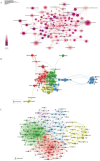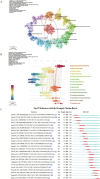Research progress in intracranial artery dissections over past 25 years: a review and bibliometric analysis
- PMID: 40534741
- PMCID: PMC12173861
- DOI: 10.3389/fneur.2025.1623956
Research progress in intracranial artery dissections over past 25 years: a review and bibliometric analysis
Abstract
Background: A bibliometric and visual analysis of articles related to intracranial artery dissection (IAD) was performed to reveal the academic developments in this research field, to better assist researchers in reviewing previous research results, exploring current scientific research hotspots and cutting-edge trends, and obtaining a global perspective on IAD research.
Methods: Articles on IAD published from January 1, 2000 to March 15, 2025 were searched, screened, and downloaded using the Web of Science Core Collection (WoSCC). All literature included in the study was analyzed using VOSviewer, CiteSpace and Microsoft Excel.
Results: A total of 1,130 articles were included in the bibliometric analysis from January 2000 to March 2025, with a general upward trend in the number of articles published each year, peaking in 2019 for annual publications. Collaboration network analysis showed that the United States, Japan, and Germany are the more influential countries in the field, with high numbers of published articles, citations, and collaborations with other countries. The journal with the most publications was World Neurosurgery. Lawton MT was the most active author with a cumulative total of 13 articles, while Biller J received the highest number of citations with a cumulative total of 1,033. Keyword analysis of the literature showed that "recanalization "reached the highest intensity of outbreaks, while "thrombectomy "," outcome ", "risk ", and "diagnosis "showed an increase in citations in 2025, indicating that these subjects continue to be of significant interest.
Conclusion: This study explores the evolving research trends and challenges in the area of IAD, presenting a thorough examination of both its historical and current research contexts. It offers valuable direction for future scholarly pursuits. By engaging in comprehensive research and examining various perspectives within the IAD domain, new insights can be uncovered, ultimately facilitating precise diagnosis and effective treatment of the condition.
Keywords: bibliometric analysis; clinical diagnosis and treatments; hotspots; intracranial arterial dissection; pathophysiology.
Copyright © 2025 Zhou, Qin, Chen, Li, Yang, Li, Wu, Wang, Guo, Zhang, Zhao and Guo.
Conflict of interest statement
The authors declare that the research was conducted in the absence of any commercial or financial relationships that could be construed as a potential conflict of interest.
Figures








Similar articles
-
Comprehensive Global Analysis of Future Trends in Artificial Intelligence-Assisted Veterinary Medicine.Vet Med Sci. 2025 May;11(3):e70258. doi: 10.1002/vms3.70258. Vet Med Sci. 2025. PMID: 40145983 Free PMC article.
-
Knowledge Mapping of Intracranial Artery Dissection: A Bibliometric Analysis (2014-2024).World Neurosurg. 2025 Aug;200:124172. doi: 10.1016/j.wneu.2025.124172. Epub 2025 Jun 11. World Neurosurg. 2025. PMID: 40513818 Review.
-
A bibliometric analysis of research trends in mesenchymal stem cell therapy for neonatal bronchopulmonary dysplasia: 2004-2024.Front Pediatr. 2025 Jun 3;13:1558301. doi: 10.3389/fped.2025.1558301. eCollection 2025. Front Pediatr. 2025. PMID: 40530182 Free PMC article. Review.
-
Trends and hotspots in global influenza and intestinal flora research based on bibliometrics.Front Microbiol. 2025 Jul 28;16:1630924. doi: 10.3389/fmicb.2025.1630924. eCollection 2025. Front Microbiol. 2025. PMID: 40792264 Free PMC article.
-
Driving innovations in cancer research through spatial metabolomics: a bibliometric review of trends and hotspot.Front Immunol. 2025 Jun 10;16:1589943. doi: 10.3389/fimmu.2025.1589943. eCollection 2025. Front Immunol. 2025. PMID: 40557160 Free PMC article.
References
Publication types
LinkOut - more resources
Full Text Sources
Miscellaneous

